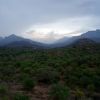ජනශූන්ය ශිඛර අභයභූමිය
Peak Wilderness sanctuary is a natural reserve in Sri Lanka. It is the third largest (by area) of the 50 sanctuaries in the country.[2]
Peak Wilderness sanctuary is a tropical rain forest that spreads over a land of 224 square kilometers around the Sri Pada (Adam's Peak) mountain. A huge forest area that belonged to the Peak Wilderness was cut down and cleared during the British colonial rule in Sri Lanka (1815-1948) to gain land for the massive tea estates which are still functioning in Nuwara Eliya district. The remaining portion of the Peak Wilderness was declared a wildlife sanctuary on October 25, 1940.
The contours of Peak Wilderness vary from 1000 to 7360 feet above sea level. Therefore, it possesses unusual geographical formations compared to the other natural reserves of the island. Bena Samanala (6579 ft), Dotalugala, Detanagala, are some of the taller mountains in the Peak Wilderness. It is also the birthplace of Kelani, Kalu, Walave rivers and many tributaries of the river Mahaweli which make waterfalls such as Dotalu falls, Geradi falls, Galagama falls (655 ft), and Mapanana falls (330 ft) inside the sanctuary.
Out of the 3 access routes; Hatton route, Kuruwita route and Palabaddala route, which Buddhist devotees and other tourists use to reach the Adam’s Peak, Kuruwita and Palabaddala routes go right across the Peak Wilderness sanctuary. This forest area is entirely under the control of Sri Lanka Wildlife Conservation Department. It does not maintain any lodge, bungalow or such type of facility for tourists inside Peak Wilderness sanctuary in order to safeguard the purity of this forest. Yet, there is no restriction for eco-tourists to enter the sanctuary after obtaining permission from Sri Lanka Wildlife Conservation Department. Entering the sanctuary during the rain season is at the tourist’s own risk because of the unforeseen downpours and instant floods lead to life-risk situations.
LOWER ELEVATIONS
Ceylon Blue Magpie, Ceylon Rufus Babbler, Ashy Headed Laughing Thrush, Layard’s Parakeet, Ceylon Green Pigeon, Black Eagle, Mountain Hawk Eagle, Ceylon Grey Hornbill, Ceylon Crested Drongo, Ceylon Green Pigeon, Ceylon Trogon, Orange Minivet, Green-billed Coucal, Ceylon Jungle Fowl & Ceylon Spur fowl and many more.
HIGHER ELEVATIONS
Ceylon Whistling Thrush, Yellow-eared Bulbul, Ceylon Hill White Eye, Grey-headed Flycatcher, Ceylon Black Bird, Dusky Blue Flycatcher, Ceylon Wood Pigeon, Scaly Thrush, Mountain Hawk Eagle and many more.
Location Central and Sabaragamuwa provinces, Sri Lanka
Nearest city Ratnapura
Coordinates 6°48′47″N 80°29′04″ECoordinates: 6°48′47″N 80°29′04″E
Area 22,379.1 ha
Established October 25, 1940
Governing body Department of Wildlife Conservation
World Heritage Site 2010 (within the site Central Highlands of Sri Lanka)[1]
Listing Details
Mobile
+94 77 888 5552







